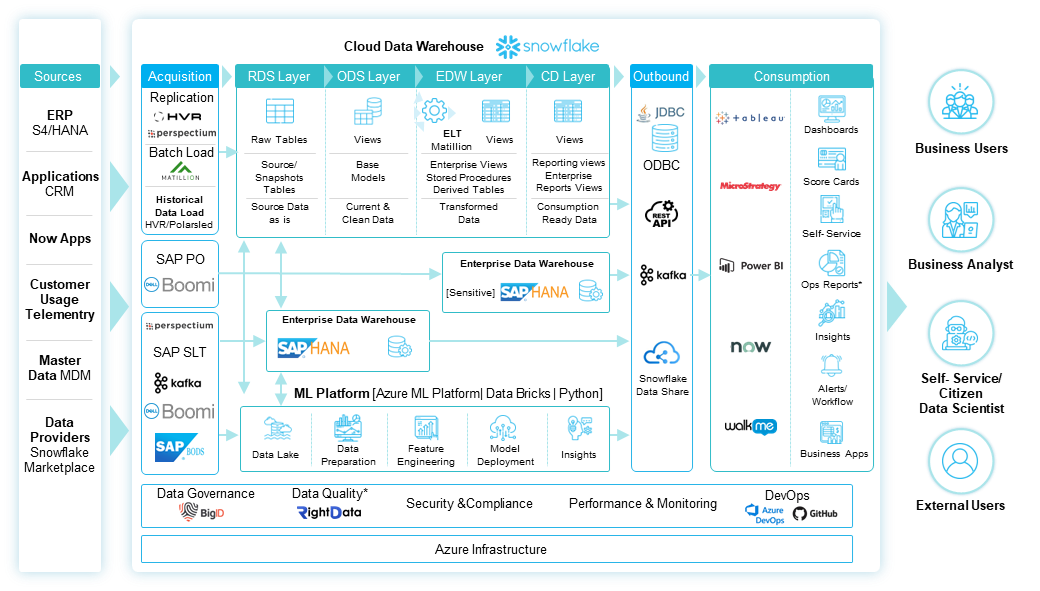Building a Faster Future with ServiceNow’s Journey with Enterprise Data Platform on Snowflake Data Cloud
In our rapidly evolving world, where technology is at the forefront of almost everything, it’s essential to leverage it as a catalyst for change. One such innovation is ServiceNow’s journey with the Enterprise Data Platform on Snowflake Data Cloud. To stay ahead of the competition and keep up with the changing times, it’s critical to understand how this platform can help you.
To begin, the first step is to look at the data sources, data processing, and consumption. Data processing is a critical aspect, and there are five ways to receive the data, In addition, there are a few barriers to extracting/retrieving data which are also mentioned below:
- Cross-functional semantic layers with complex computing requirements can help simplify the process.
- High support costs systems and highly trained resources can ensure efficient data processing.
- Many failure points and rigid codes
- High instability due to large data volumes
- No version control and high enhancement costs
Consumption is another critical aspect that builds on the data obtained. Live dashboards, reports, and custom outbounds are three popular ways of consuming data. It’s noteworthy that when the data consumption is not organized or curated, it results in many unusual reports, which can become cumbersome for the users.
The “right fit” analytics platform will play a crucial role in the future. It favors frameworks and tools over purpose-built components, which ensures the scalability of the platform. It also favors managed services and platforms as a service (PaaS) as they address current limitations and pain points. This is because they are affordable to build and run, have a faster time to market, and can scale rapidly and cost-effectively to meet any new demand.
Another significant aspect to consider is choosing the “right fit” partner for faster system integration. The partner should understand the organization’s needs and objectives and recommend affordable and sustainable solutions. The partner chosen must also address current pain points as part of the proposal.
The approach involves migrating all SAP objects to Snowflake-compatible objects and optimizing them to improve performance. The existing extracts are re-engineered and transformed for SAP BODS, Dell Boomi, to Matillion ingestion pipelines. This is carried out through a reusable/near-real-time ingestion framework. Near real-time replications of data are set up using HVR and Perspectium. The final step involves repointing Tableau, Power BI, MSTR, and BO reports to Snowflake. To carry out this transition, key considerations such as meeting data freshness SLAs and delivering acceptable performance must be considered. It is vital to eliminate any technical debts and rationalize the overall process for successful implementation. Furthermore, post-implementation support is essential to ensure the success of this process transition.
Migration Approach

In conclusion, ServiceNow’s journey with Enterprise Data Platform on Snowflake Data Cloud has brought about significant growth and change in the technological field. Understanding how to build with this platform is important for organizations that want to stay ahead of the competition and keep up with the times. Hence, choosing the right analytics platform that favors frameworks and tools over purpose-built components, a partner that addresses current pain points, and data processing and consumption that is organized and curated is essential in building a faster future.
More from Deepak Khosla
Generative AI (Gen AI) is the latest buzzword in the IT industry, promising to revolutionize…
Innovation is the lifeblood of a business. The arrival of generative AI (Gen AI) heralds a…
Latest Blogs
Leveraging the right cloud technology with appropriate strategies can lead to significant cost…
Introduction The financial industry drives the global economy, but its exposure to risks has…
On January 17, 2024, the Centers for Medicare and Medicaid Services (CMS) released the Interoperability…
The energy and anticipation were evident even before entering the arena, and attendees had…




